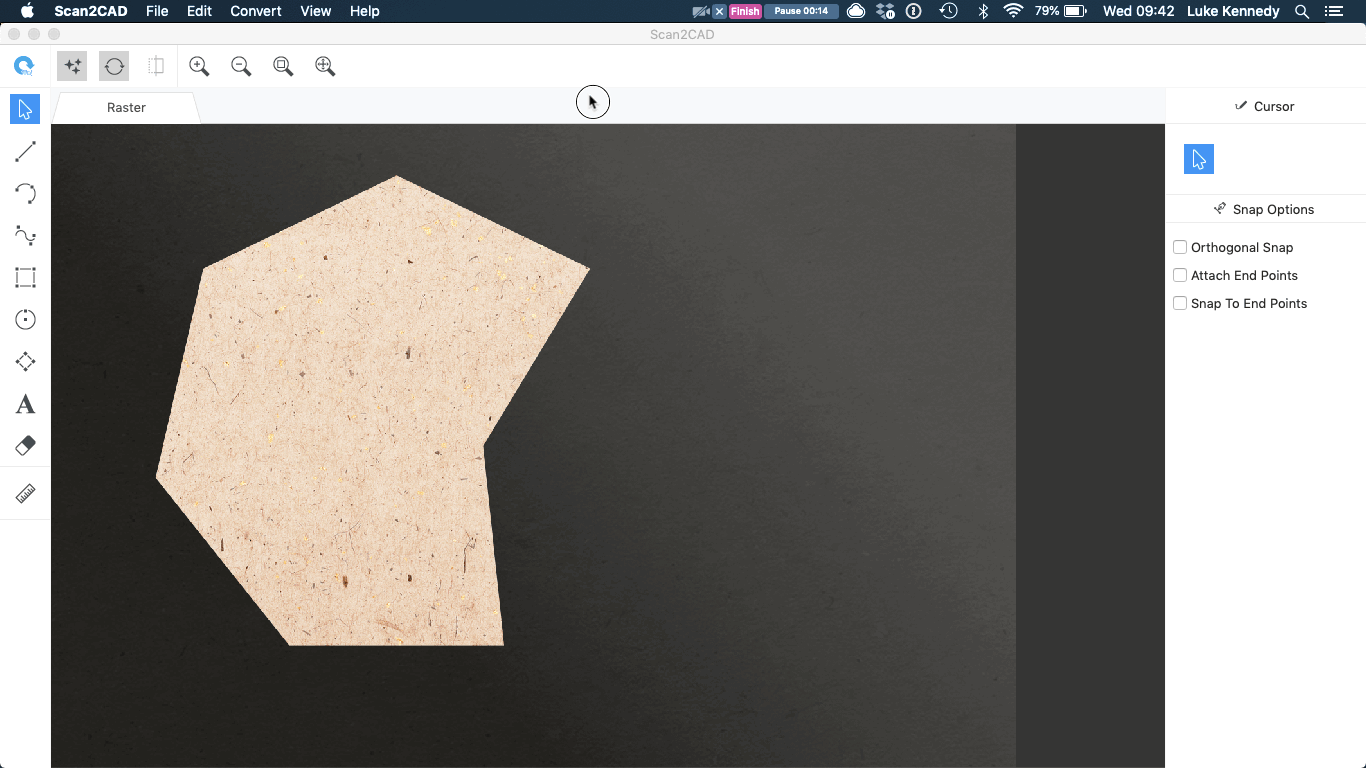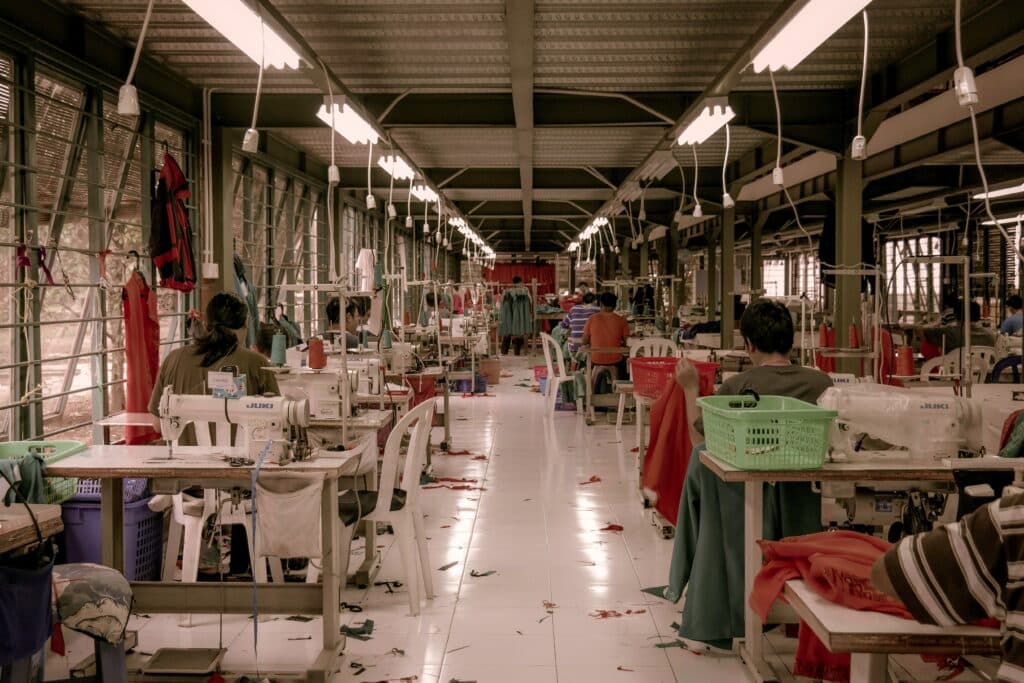Hobbyist needleworkers and large clothing industries alike make use of digitized apparel patterns to accurately and quickly cut designs for prototyping. In the design and manufacturing processes, these apparel patterns are vital in duplicating and developing apparel designs. The use of computerized versions and CNC cutters cut back on errors and the time it takes to create iterations of the design, very efficiently cutting down the time it takes to reach a final design and put the product out to market. But how do industries go about converting hand-drafted or sketched apparel patterns into CAD copies?
In this article, we’ll be taking a look at what digital apparel patterns are and how they’re used in the manufacturing and design industries. We’ll also explain one of the fastest ways to digitize your patterns for CNC and CAD work – our very own Scan2CAD software.

Digitizing an apparel pattern with Scan2CAD.
Table of Contents
The Importance of Apparel Patterns
In clothing and apparel design, apparel patterns are templates used to translate the shapes of the parts of a design on fabric and textile before the materials are cut out and assembled. Usually, these patterns will be made out of paper products due to their affordable and disposable nature. Sometimes though, companies will opt for paperboard or cardboard when they plan on reusing these templates repeatedly.
Simply put, apparel patterns are used for cutting out the parts needed to create clothing and other apparel. They specify individual edge measurements and cutting angles for the material that needs to be cut out. Just as furniture designers and architects use blueprints in their craft, apparel patterns are integral in putting down and communicating information about different clothing and accessory designs. These clothing designs produce a variety of garments, shoes, outerwear, and even seat covers.

This patternmaking process is relatively straightforward. Designers and crafters will take whatever pattern they have in mind or the client has in mind and sketch or draft them onto paper. All that’s left to do after that is to cut out the pattern and then you have an apparel pattern.
As time-honored and classic as the manual patternmaking methods are, due to the advancement of technology and manufacturing methods, most big industries already prefer to create digital copies of their patterns. They convert regular paper patterns sketched out onto paper into CAD versions to be used with CNC machines. Like computer-generated blueprints, these digitized apparel patterns are faster to create, replicate, archive, and edit.
Benefits of Digitizing
If you’ve stumbled upon our humble Scan2CAD articles, it might be safe to assume that you’re aware of the benefits of using CAD/CAM files when it comes to designing for manufacturing. Or at the very least, you’re curious about how digitizing designs can help your workflow. With that said, let’s talk about how digitizing your apparel patterns will help you out:
Quick Iterations and Reiterations
In the old times of manual apparel patterns, creating two different versions of a template entails creating two different sets of apparel patterns for them, essentially doubling the amount of time it takes for you to manually cut out the templates. This would have been the case even if the two versions have the smallest amount of difference between them – perhaps a slightly higher cut or a taper that’s different by 1 or 3 inches. With digitized apparel patterns, small changes like these will take a proportionally small amount of time, since it’s only a matter of copy-pasting the original version. Not to mention, with the advancement of computerized drafting programs, it has never been faster or easier to use CAD software.
With digital templates, you can create different versions of varying sizes, slightly altered cuts and tapers, or even brand new designs using design elements from old designs. The amount of time you save from working on digitized patterns as opposed to the time it would take to make manual patterns is well worth considering taking all of your manual paper templates and digitizing them.
Team Effort
Creating manual, physical apparel patterns would most likely be a logistical nightmare nowadays. The locational considerations and the transportation involved in bringing physical templates to and from collaborative designers and eventually to the manufacturing plant are large variables when it comes to the success of a design. This isn’t even accounting for the possibility of mistakes or edits in the design, which will entail repeated correspondences between parties. This noticeably slows down the movement of the design from conception to final manufacturing. In the old days, designers would also be limited by how far they can mail their designs. If there isn’t a suitable apparel manufacturer within mailing distance to you, you might as well give up any hope on the large-scale production of your design.
With digital apparel patterns, you can create edits and send over design files through email and the web. There are even advanced CAD programs that are cloud-based so any updates will be known by all involved in real-time. This also means that location will be a virtual non-issue for everyone since the only factor that matters now is the presence of the internet.
Sustainable and Resilient
As most physical objects do, physical apparel patterns are prone to wear and tear. This is especially tricky since these templates depend on their physical integrity to accurately communicate the measurements that need to be followed for the designs involved. Eventually, there will sizing and fit issues and all you will have to blame is the worn down physical apparel pattern.
Digitized patterns, however, don’t need to worry about this type of dilemma. As long as the files involved are safe and intact, you will never have to worry about skewed sizes due to inaccurate old templates. An inch will always be an inch with digitized patterns, no matter how long ago these patterns were drafted up. Not to mention that this type of drafting is much more sustainable in the long run when it comes to storage. Archiving it on your computer will save much more room than keeping old physical templates in a storage box somewhere. Additionally, the searching and cataloging of templates will be a breeze when the apparel patterns are digital.

Digitized apparel patterns can be cut using CNC machines
The Process of Conversion
Now, we’ve discussed how digital conversion of your patterns is a must nowadays, but how exactly do we go about that? The most hassle-free way to do that is through online conversion services. Most of these services will request for a raster scan of your physical copy and then either uploading or emailing the scanned copy. For those of you who would rather take care of the digitizing yourself, there are manual or automatic ways to take care of that using software, Scan2CAD being a type that does the latter. Let’s talk about these methods more in detail, but be aware that all these methods entail having a scanned version of your drawn-up apparel pattern. So be prepared with a scanner or a really good camera:
Conversion methods
Manual tracing
Most vector-capable image software will be more than enough to create vectorized versions of your scanned apparel patterns. There are ways to manually trace the images using vector tools, although these tend to be time-consuming especially for more complex templates. On the other hand, some of these applications are capable of automatic tracing, although you’ll have to adjust the settings and fine-tune the vectors if you want it to be completely accurate. Some of these programs include Adobe Illustrator, CorelDRAW, AutoCAD, and Inkscape.
This method is ideal for the hobbyist needleworker who has plenty of time on their hands. But it becomes a bit tricky to use these programs for larger scale or more complex productions.
Online converters
A quick Google search will give you tons of online converter websites that offer a free way to convert your scanned apparel patterns into digital copies. Most of these websites will come with a catch, though. Best case, you get a digital copy that has a little bit of a watermark. Most times, you’ll probably get a copy that isn’t of the best quality but is good enough for simple uses. Worst case scenario, your security might be put in risk with shadier websites or the possibility of inadvertently downloading malware or viruses, not to mention the fact that you’ll have to upload your pattern onto a site’s database for their people to see.
Automatic tracing with Scan2CAD
Here at Scan2CAD, we offer one of the best ways to digitize your apparel patterns. Scan2CAD is a raster-to-vector conversion software that promises the most accurate and efficient results. Any raster images – in this case, your scanned apparel pattern – will be accurately converted into a vector file such as DWG or DXF that will be ready for use in your CAD software of choice. Scan2CAD can support all different types of raster and vector types, so you won’t have to worry about file format compatibility.
Using Scan2CAD
First off, as with any raster-to-vector conversion process, it’s paramount that you start off with a suitable raster image. Don’t make do with low-quality photographs or scans. Ramp up the settings of your scanner, delete or edit out any smudges or unwanted marks, and make sure that the raster image is as crisp and clean as possible. It’s also advised to save your images using the TIFF format. This format comes with lossless compression and offers the best output when put through the conversion process.
Next, customize your vectorization settings and then the software will do the rest when it comes to detecting the lines and shapes and tracing them over. The actual conversion process of Scan2CAD can take as short as seconds to complete.
Video: Digitize apparel patterns with Scan2CAD
In the following tutorial video, we’ll walk you through the process of taking your apparel pattern and converting it into a vector image using our software.



